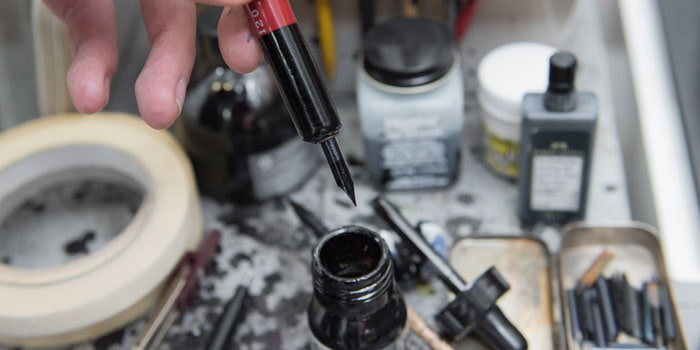The importance of having a studio space

For illustrator Matthew Frame, moving to a studio space has been invaluable, completely changing the way he approaches his practice – find out why.
Illustrator, Matthew Frame has a beautifully intricate, recognizable style that can be seen across both small-scale editorial illustrations and large-scale murals. Find out why moving to a studio space has completely changed the way he approaches his practice, the role social media has played in his career so far and why, in a world that’s heavily digital, he prefers to work with analog production techniques.

Tell us about you, Matt
Working from my studio space in Dalston, London, I create intricate black and white drawings that explore my passion for film, politics, education, environmental issues and science fiction. I have an analog production technique and design outlook that underpins my approach to commissions. I have a very research-led practice that explores meta-narratives within illustration and how the medium is an essential tool for conveying complex ideas and information effectively.

How did you get into illustration? Tell us about your journey so far.
My parents are very into art. Dad is obsessed with Andy Warhol – he’s got pretty much every book that’s ever been published. So, from a very young age, it was impressed upon me that art is this very important thing.
I got into comic books – it became a bit of an obsession really – I used to draw all the time, copying the images [from the comics] and I quickly made up my mind that I wanted to study something art related.
I went on to study fashion design for 2 years, but I soon realized it wasn’t really for me. Looking back, I think it was important for me to have that time as it really helped me discover that it was actually illustration that I was really passionate about. So, I came back to London to study Illustration and Animation at Middlesex University and at that point I thought, ‘Ok right, this is what I want to do.’
I then went on to do my Masters Degree in Communication Design at Central St Martins, which was great! It led to me illustrating a book – The Bright Labyrinth – for one of my supervisors who’s a cultural theorist. The graphic designer who worked on the project was part of an Indian publishing house called Tara Books, she put them in touch with me and they asked me if I wanted to illustrate a book called The Boy Who Speaks in Numbers, about the Civil War in Sri Lanka. It was great, and such an interesting brief but also quite difficult as I had to try and depict violence and the horrors of war without actually showing any violence.
Following this brief, things really propelled and I started to build up a relationship with Tara, the publishing house. They asked me to do two further books for them as part of an artist residency in India which was such an amazing experience!
In a world that’s heavily digital, you prefer to work with analogue production techniques – why is this?
I’m a big fan of Aubrey Beardsley and William Morris – I love that very ornate, Victorian style. Beardsley especially – he’s very influential and has inspired a whole generation of artists, inventing a new way of drawing that worked with reproduction, like printing.
Going back to my dad and his Andy Warhol influence, I was also really obsessed with screen printing when I was growing up, and still am. My black and white style that features so heavily in my work came from me drawing things up for print. I do work in color but I just really love the interplay between black and white and seeing how far I can push those two colors. I’ll often use textures, lines and dots too, which allows me to add depth to my work. I love the challenge that comes with only using two colors.
Talk us through your process. How do you like to approach client briefs?
When it comes to illustration for books, I like to read the book at least twice. The first time, I’ll fully immerse myself in the narrative and the second, I like to make notes in my sketch book. From there, I’ll go on to create a series of thumbnail sketches with annotations and send them to the publisher to get their thoughts and feedback. It’s a really collaborative, organic process with the authors and publishing house, which I love.
My large scale murals are usually just an extension of my practice. Apart from the medium and the scale, things don’t really change that much. I’ll always do a site visit and take lots of photographs. Then, I’ll move on to concepts, creating thumbnail sketches in the same way as I would for a book brief and send them off the client. I’ll go through a couple of stages of idea development with the client and once the final design is signed off, I’ll usually spend about a week on some scaffolding, painting and bringing the design to life.
Why did you decide to go freelance?
My career’s been a bit of an ongoing process so far and I’m never quite sure which direction it’s going to take me in. I was actually approached by an architecture firm pretty early on to do a large scale mural for them, it came out of the blue and was something I’d never done before but I really wanted to give it a go. It was quite coincidental really and going freelance kind of just happened from there.
You run your business from your studio space – how do you manage your time and do you have any tips for others thinking of setting up their own studio?
It’s helped massively. I’d never really spent that much time around other creatives and freelancers but moving into a shared studio means I can be around other like minded people. We chat about the briefs we’re working on and ask each other for advice – it’s really invaluable.
When I was working from home, I found that I had a bit of a perpetual student existence where I was never away from my work. I ended up working really long hours but moving into the studio space has really helped me focus, partitioning up my day and planning my workload better. Having somewhere to go has also helped me to approach things in more of a professional way.
I really would recommend getting a studio space if you can!
You exhibit your work a lot – what are your tips for artists who may also be thinking about exhibiting their work for the first time?
There’s various different things you can sign up for, like Art News and Art Jobs. They’ll advertise upcoming exhibitions and you can submit your work digitally to those that sound like they might be the right fit for you and what you do.
Sharing a studio space and having people around me that are working in a similar field means that we can share tips and knowledge which is really helpful. I’d also recommend just sending your work to anyone you think might be interested and getting your name out there – printing your work onto Postcards and mailing them is a great way to do this.
How do you stay inspired?
Most of my inspiration comes from cinema, poetry, cultural theory and political events and situations. I don’t tend to draw too much inspiration from illustration but I do like go to exhibitions.
What role has social media played in your career?
Instagram and other similar platforms are really important and fantastic for getting your work out there but they can also make things incredibly stressful at times, leading to a bit of a struggle for validation. I’ll sometimes find myself comparing my work, methods or number of followers to other artists.
I’ve spent time consolidating my online presence and I now use my website as my shop window so to speak, it’s got everything on it – links to my shop, my blog and my social channels.
Instagram tends to be my go-to channel and has definitely changed the way I find work, and the way in which people find me, too. You always have to remember; do your own thing and find your own voice, don’t follow what everyone else is doing.
What’s the biggest thing you’ve learnt on the road to setting up your business?
Show your work. It can be a really hard slog at times – some people are lucky and others have to work a little more at it. Social media can be a bit of a double-edged sword – the people who are going to commission you have the choice of the whole world whereas back in the day, it was just a choice between the illustrators in London, for example. But on the other hand, it does give you access to so many more potential clients.
I often find that people still expect you to work for free at times. There’s a bit of an assumption that anyone who works in the creative industry does it for fun – it’s a hobby not a job. In these cases, you have to be a little bit more business minded which can take time to develop but putting a contract in place always helps.
How do you use MOO’s products to promote your business?
I’ve got a whole collection of MOOcards – I’ve used MOO for years and my Business Cards and Postcards have become a mini-portfolio of all my work over the years.
I’ll use Postcards as little mailouts too – they’re great for sending samples of my work along with a little handwritten message to editorial agencies that I think might be interested in my work.
Create your own Postcard portfolio
Photography by Paul John Bayfield
Keep in touch
Get design inspiration, business tips and special offers straight to your inbox with our MOOsletter, out every two weeks.














